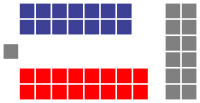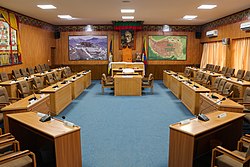This article needs additional citations for verification. (September 2016) |
Parliament of the Central Tibetan Administration གྲོས་ཚོགས་ཐོག་གསུང་བཤད། | |
|---|---|
| 17th Tibetan Parliament | |
 | |
| Type | |
| Type | |
Term limits | None |
| History | |
New session started | 2021 |
| Leadership | |
Speaker | Ven. Khenpo Sonam Tenphel[1] since October 2021 |
Deputy Speaker | Dolma Tsering[2] since October 2021 |
| Structure | |
| Seats | 45 |
 | |
Political groups |
|
Length of term | 5 years |
| Elections | |
| Plurality block voting | |
Last election | 2021 |
Next election | 2025 |
| Meeting place | |
 | |
| Building of Central Tibetan Administration, Dharamshala, Himachal Pradesh, India | |
| Website | |
| tibetanparliament | |
The Tibetan Parliament in Exile (TPiE), officially the Parliament of the Central Tibetan Administration, is the unicameral and highest legislative organ of the Central Tibetan Administration, the government-in-exile of the Tibet Autonomous Region of China. It was established and is based in Dharamshala, India. The creation of this democratically elected body has been one of the major changes that the 14th Dalai Lama brought about in his efforts to introduce a democratic system of administration.
Today, the parliament consists of 45 members: ten members each from Ü-Tsang, Kham, and Amdo, the three traditional provinces of Tibet; the four major schools of Tibetan Buddhism and the traditional Bön faith elect two members each; five members are elected by Tibetans in the west: two from Europe, one from Australasia, one from North America and one from Canada. The Tibetan Parliament in Exile is headed by a Speaker and a Deputy Speaker, who are elected by the members amongst themselves. Any Tibetan who has reached the age of 25 has the right to contest elections to the parliament.
The elections are held every five years and any Tibetan who has reached the age of 18 is entitled to vote. Sessions of the parliament are held twice every year, with an interval of six months between the sessions. When the parliament is not in session, there is a standing committee of eleven members: two members from each province, one member from each religious denomination. The members of the parliament undertake periodic tours to Tibetan settlements to make an assessment of people's overall conditions. On their return, they bring to the notice of the administration all the grievances and matters which need attention. The Tibetan Parliament in Exile also keeps in touch with people through local parliaments established in thirty-eight major Tibetan communities. The Charter provides for the establishment of a local parliament in communities having a population of at least 160.
Local parliaments are scaled-down replicas of the Tibetan Parliament in Exile. They keep an eye on the activities of their respective settlement/welfare officers. They also make laws for their respective communities according to the latter's felt-needs. Laws passed by local parliaments must be implemented by their respective settlement/welfare officers.
- ^ "Khenpo Sonam Tenphel and Dolma Tsering are elected Speaker and Deputy Speaker of 17th Tibetan Parliament-in-Exile". Central Tibetan Administration. 8 October 2021. Retrieved 9 September 2022.
- ^ "Khenpo Sonam Tenphel and Dolma Tsering are elected Speaker and Deputy Speaker of 17th Tibetan Parliament-in-Exile". Central Tibetan Administration. 8 October 2021. Retrieved 23 September 2022.